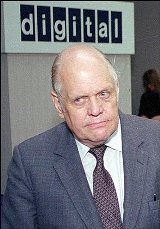 In the 1960s and 1970s, DEC played a central role in creating the market for "minicomputers," powerful, refrigerator-sized machines that appealed to scientists, engineers and other number crunchers who did not need the bigger, multimillion-dollar mainframes used by big corporations. At its peak in the 1980s, DEC was the second-largest computer maker behind IBM.
In the 1960s and 1970s, DEC played a central role in creating the market for "minicomputers," powerful, refrigerator-sized machines that appealed to scientists, engineers and other number crunchers who did not need the bigger, multimillion-dollar mainframes used by big corporations. At its peak in the 1980s, DEC was the second-largest computer maker behind IBM.
"It's too easy to forget that it was Ken Olsen's vision of interactivity that took computing away from the centralized mainframe and into the hands of the people," said Gordon Bell, who joined DEC in 1960 and headed the company's engineering operations for more than 20 years.
When I began my microwave engineering career at M/A-Com, numerous microwave companies including Raytheon, Alpha Industries (now Skyworks), Analog Devices, Kevlin Microwave, Baytron helped give Rte. 128 outside Boston its reputation as America’s Technology Highway. No less significant was the presence of many computer industry giants including Data General, Computervision, Apollo Computer, GTE, EMC Corporation, Wang and of course DEC.
Taking a look back at Olsen’s academic and professional life, one quickly understands the connection between the development of computer technology and microwave systems, the former enabling the advances of the latter, both employed together to create the complex defense systems necessary to fight the cold war.
Olsen was born Feb. 20, 1926, in Bridgeport, Conn. His father designed machine tools and Olsen and his brothers spent hours tinkering with gadgets in the family basement. During World War II, Olsen attended the Navy's electronics school. He later earned bachelor's and master's degrees in engineering from the Massachusetts Institute of Technology.
At MIT, Olsen worked in the university's Lincoln Laboratory, the research center responsible for developing the technology to improve the nation's air defense system. That technology grew into the Air Force's Semi-Automatic Ground Environment defense system, which was used to track and intercept enemy aircraft. One of Olsen's roles at Lincoln Laboratory was to serve as a liaison with IBM, a major contractor on the project. Olsen also worked on Lincoln Lab's TX-2 computer, which helped break new ground in computer-aided drafting.
In 1957, Olsen teamed with MIT colleague Harlan Anderson to start Digital Equipment Corp. in Maynard, Mass. DEC named its first computer the PDP-1, for Programmed Data Processor. But it was the PDP-8, which was introduced in 1965 and became a building block for computer systems made by other companies, that really established minicomputers as a major new industry. - from API
The PDP-11 — and later DEC's Virtual Address eXtension, or VAX, series — offered a serious alternative to IBM's central mainframe approach. Digital was also a pioneer in the use of networking technology to link its computers together.
DEC's innovations made their machines accessible to small and medium-sized operations and even individual users. Prior to these new machines, many engineers performed their design work on extremely expensive time-shared mainframes. By the mid-80’s, every engineer developing GaAs MMICs at M/A-com’s Advanced Semiconductor had a computer terminal on their desk networked to the company’s VAX mainframe. With Supercompact running on this VAX, we were able to code circuits with netlists (BLK, TRL, MSTEP, RES, FET, etc.) for simulation. Circuit layout was handed over to the CAD group using Calma layout tools on Apollo, HP and Sun workstations.
"The computers we built were of a cost and size that they brought computing down a level," said Bell, now a principal researcher in Microsoft Corp.'s Silicon Valley Research Group.
DEC computers also trained and influenced many key players in the technology industry. Microsoft co-founders Bill Gates and Paul Allen used the PDP-10 to create the first version of the BASIC programming language for a personal computer. Dave Cutler, who developed several key operating systems for DEC, went on to develop the Windows NT and Azure operating systems for Microsoft.
DEC in the Test Lab
The IBM PC and Apple’s Macintosh (introduced in a stunning TV commercial take-off on George Orwell’s 1984 ) would come to dominate the desktop computers found in most engineer’s offices and labs in the late 80’s, but the DEC PDP-11 was a work horse mini-computer for our research lab at Raytheon. With this min-computer, the newly developed GPIB bus and basic (and Fortran) programming, we built automated test and data acquisition systems in the development of millimeter-wave semiconductor technology.
Today with the internet, Facebook, Google, windows, etc. it is easy to forget the pioneering work of early computer technology, see video of re-built PDP-11 from 1987 operating RT-11 basic).
In 1998, Compaq Computer Corp. bought what was left of DEC for $9.6 billion. Four years later, Compaq and the remnants of DEC were acquired by Hewlett-Packard Co. While Ken Olsen was not exactly a member of the microwave community, his impact on our technology cannot be denied. We owe much to this visionary entrepreneur.
